Hello World!
Welcome to WordPress. This is your first post. Edit or delete
Padideh Sadrab Paya company has reverse engineered the G-ST-P/S gasket of German company KROLL&ZILLER in different sizes. These gaskets are used in various industries and have very diverse applications. Non-standard design can be done based on the customer’s sample or specific design.
These gaskets are produced with various thermoplastic materials such as SR, VITON, NBR, Chloroprene, EPDM and are used in various industries.
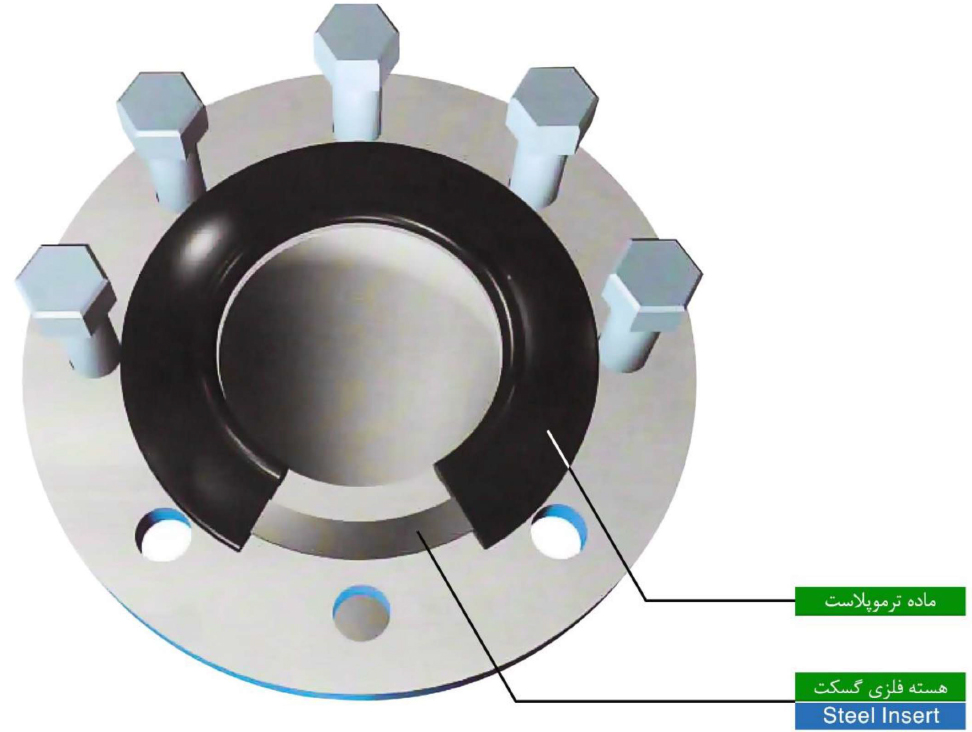
The structure of this type of gasket is a combination of metal and plastic or any other thermoplastic material, in which a metal with a thickness of about 1.5 mm is embedded in its central core. The inner part (inner diameter) is in the form of O-Ring, and the continuation of the gasket is in the form of a cube, which is produced integrally.
1. Due to having a core, these gaskets are not deformed even under high pressure and maintain their stability, while other rubber gaskets get wrinkled and shrink under pressure.
2 . This type of gasket is the best choice for connecting fiberglass flanges to fiberglass and metal flanges.
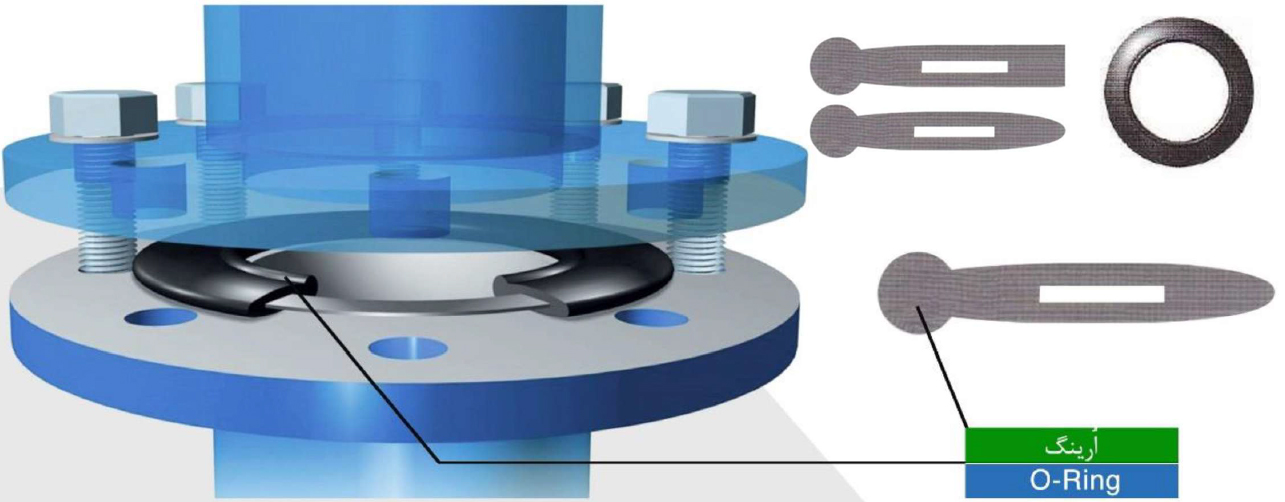
3. The built-in O-ring at the end of the gasket works great even in the absence of grooves on the flange bottom. The amount of high pressure of the flange bottom (caused by fluid force and test pressure) is absorbed by the metal core and the rigid part of the gasket. The built-in O-ring is compressed and provides a proper seal even with the lowest surface pressure.
4. The ring inside the gasket even compensates for misalignments, flange bottom angle deviations, grooves, elevations, and flange bottom defects.
5. Due to the fact that the knowledge of making this type of gasket has become local, they are not limited in size and shape. The surfaces involved with the flange surface easily find their place on the flange surface and create good sealing.

6. For inch sizes and above with pressure greater than PSI 100, it is recommended to use this type of gasket.
7. Due to the use of a different structure of this type of gasket, it does not require a lot of torque and provides proper sealing with a lower torque, so it minimizes the stress on the R flange part and reduces the possibility of cracks in this area. This point is important for GRP and polyethylene flanges that have a brittle structure.
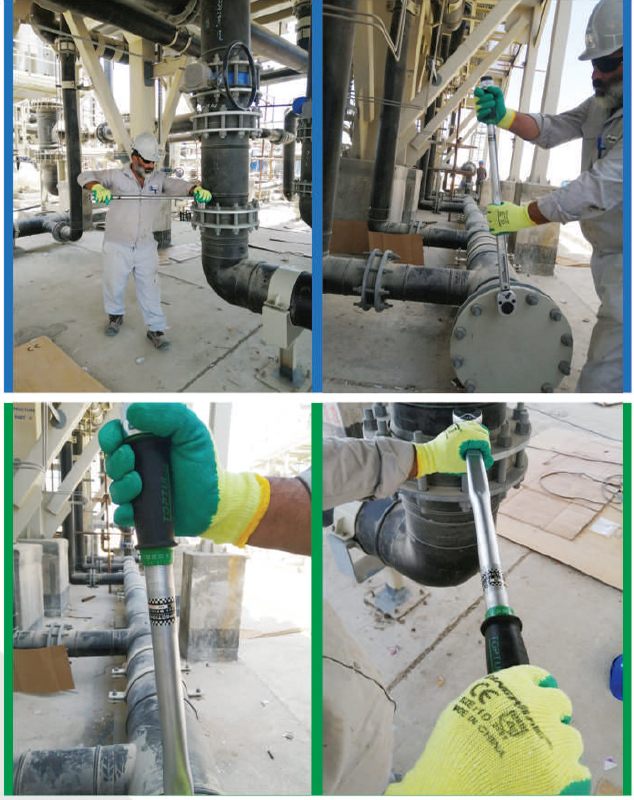
8.The curve below compares the minimum torque required for three different types of flat gaskets, gaskets with a metal core, and gaskets with a metal core and O-ring. As can be seen, at a pressure of 10 bar, the flat gasket needs more than 110Nm and the gasket with a metal core needs 85Nm of torque, while the gasket with a metal core and ring edge provides proper sealing with only 18Nm. As mentioned in paragraph 7, the ring edge designed in these gaskets is pressed with low pressure and does not require excessive tightening of the screws. While in the case of other gaskets, sometimes due to the lack of proper sealing in the test pressures, it is clearly observed that the screws need to be re-tightened, which causes excessive tension and cracks in the R part of the flange.
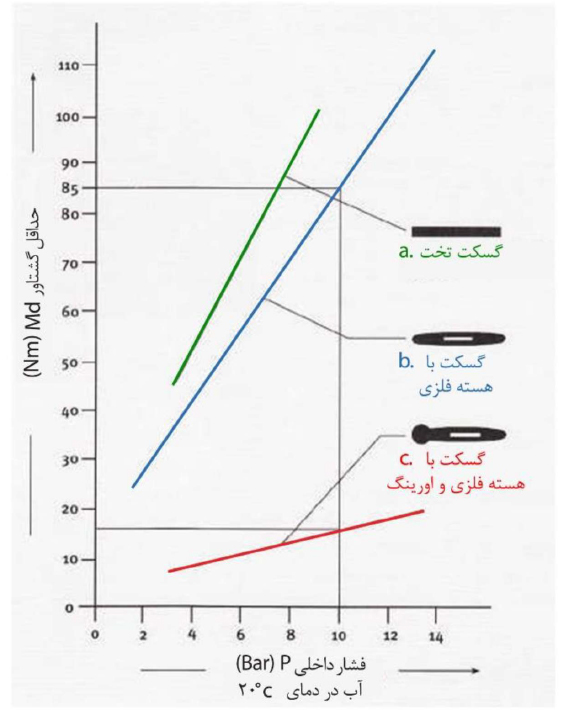
| Standard |
Tolerable pressure
(Bar) (Psi) |
class | gasket name | |
|---|---|---|---|---|
| ADME B16.21 | 40 | 150 | 150 | PSP-G-KAS |
| ADME B16.22 | 60 | 300 | 300 | PSP-G-KAS |
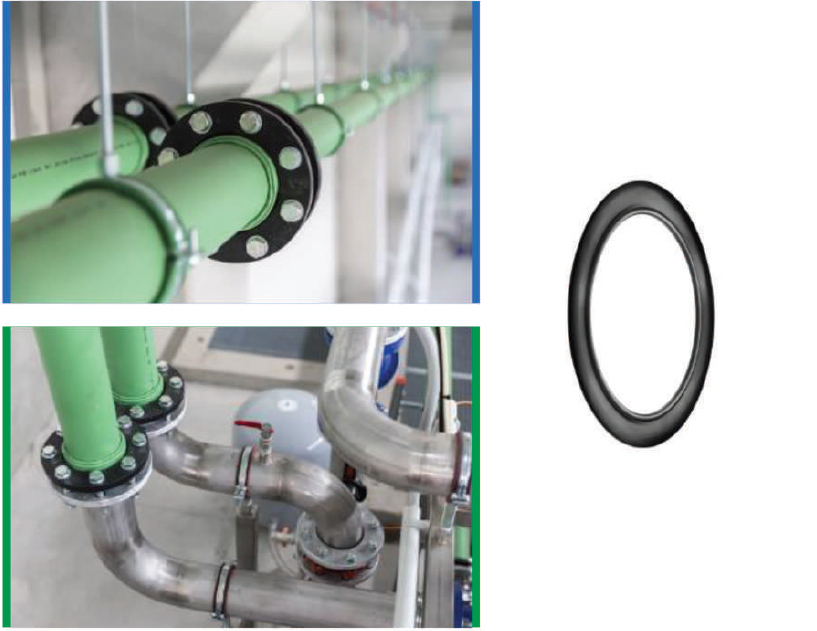
| Nominal pipe size (inch) |
Dimension in mm
Pressure class 150 Lbs (d1) (d2) (s1/s2) |
Weight (Kg) | ||
|---|---|---|---|---|
| 3/4 | 27 | 54 | 3/4 | 0.0125 |
| 1 | 33 | 64 | 3/4 | 0.0175 |
| 1 1/2 | 48 | 83 | 3/4 | 0.040 |
| 2 | 60 | 102 | 4/5 | 0.035 |
| 3 | 89 | 133 | 4/5 | |
| 4 | 115 | 171 | 5/6 | 0.065 |
| 6 | 160 | 218 | 6/8 | 0.125 |
| 8 | 219 | 273 | 6/8 | 0.190 |
| 10 | 273 | 337 | 6/8 | 0.260 |
| 12 | 325 | 406 | 6/8 | 0.415 |
| 14 | 356 | 448 | 7/10 | 0.815 |
| 16 | 406 | 512 | 7/10 | 1.155 |
| 18 | 457 | 574 | 7/10 | 0.94 |
| 20 | 508 | 604 | 7/10 | 1.325 |
| Nominal pipe size (inch) |
Dimension in mm
Pressure class 150 Lbs (d1) (d2) (s1/s2) |
Weight (Kg) | ||
|---|---|---|---|---|
| 24 | 610 | 715 | 7/10 | 1.390 |
| 28 | 720 | 829 | 8/11 | 1.712 |
| 30 | 770 | 880 | 8/11 | 2.150 |
| 32 | 820 | 937 | 8/11 | 2.555 |
| 36 | 920 | 1045 | 8/11 | 3.760 |
| 40 | 1020 | 1159 | 8/11 | 5.135 |
| 42 | 1070 | 1216 | 8/11 | 3.375 |
| 44 | 1120 | 1273 | 8/11 | 3.350 |
| 48 | 1220 | 1381 | 8/11 | 3.665 |
| 50 | 1270 | 1432 | 8/11 | *** |
| 52 | 1320 | 1489 | 8/11 | *** |
| 54 | 1370 | 1546 | 8/11 | *** |
| row | Gender | product code | Appropriateness | Inappropriateness | working temperature wrench | Shore-A hardness |
|---|---|---|---|---|---|---|
| 1 | EPDM | PSP-G-KAS-EP | Strong acids, alkalis, salts and chlorine | petroleum, solvents or aromatic hydrocarbons | -30°C and |
70±5 |
| 2 | CR-Chloroprene | PSP-G-KAS-CR | acids with medium pH, alkalis, salts, oil and fossil fuels | oxidizing acids, aromatic compounds, hydrocarbon chloride | -51°C and |
63±5 |
| 3 | NBR | PSP-G-KAS-NB | oil, gas, fossil fuels, scratch and abrasion resistance | strong oxidizers, chlorinated hydrocarbons, esters and ketones | -51°C and |
30-90 |
| 4 | SBR | PSP-G-KAS-SB | Weak natural acids, alcohols and common chemicals, ketones | Ozone, strong acids, all kinds of grease and oil and most hydrocarbons | -54°C and |
30-95 |
| 5 | VITON | PSP-G-KAS-VN | petroleum and fuel, chlorinated solvents, aromatic and fatty hydrocarbons and strong acids | amines, esters, ketones and water vapor | -26°C and |
70 |
| 6 | NR | PSP-G-KAS-NR | Resistant to solvents and petroleum substances | Ozone, oxygen, sunlight and heat | -55°C and |
25-99 |
| Characteristic | NR | NBR | CR | SBR | EPDM | VITON |
|---|---|---|---|---|---|---|
| A Hard Shore | 25~99 | 25~95 | 20~95 | 30~90 | 25~95 | 60~90 |
| weather resistance | Weak | Unacceptable | OK | Weak | Great | Great |
| Resistance to Ozone | Unacceptable | Unacceptable | OK | Unacceptable | Great | Great |
| Thermal resistance | Unacceptable | Weak | OK | Weak | Great | Great |
| Low temperature resistance | OK | Weak | OK | Weak | Great | Great |
| Acid resistance | suitable | OK | OK | OK | Great | Great |
| alkali resistance | suitable | OK | OK | Weak | Great | Great |
| Resistance to mineral oil | Unable | OK | OK | Unable | Unable | Great |
| Resistance to vegetable oil | Weak | Great | OK | Weak | OK | Great |
| abrasion resistance | Great | Great | OK | Great | OK | Weak |
| tear resistance | Great | OK | OK | Weak | Weak | Weak |
| power specification | Great | OK | OK | suitable | OK | Unacceptable |
| Compression | Great | OK | OK | OK | OK | OK |
| Impact resistance | Great | OK | OK | Great | OK | Weak |
| characteristic of being gas tight | Weak | Weak | OK | Weak | Weak | Unacceptable |
| Flame resistance | Unacceptable | Weak | OK | Unacceptable | Unacceptable | Great |
| electrical characteristic | OK | Unacceptable | Unacceptable | Weak | Great | Great |
| color constancy | OK | suitable | Unacceptable | OK | Great | OK |
| color constancy | OK | suitable | Unacceptable | OK | Great | OK |
| sticky | Great | OK | OK | Weak | Weak | Great |
| function | Great | OK | Weak | OK | OK | OK |
| Water resistance | Great | OK | OK | OK | Great | Great |

The gaskets of this collection are specially made with pay attention to Needs are designed for different industries and Can be used in pipelines with different materials (metal, polyethylene, composite, etc.).
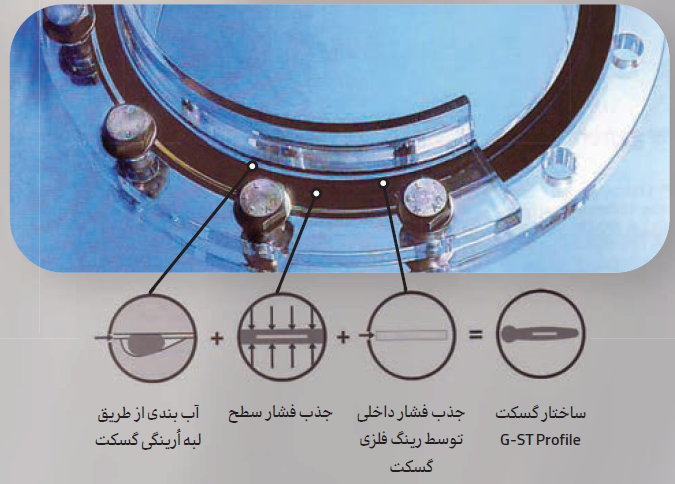
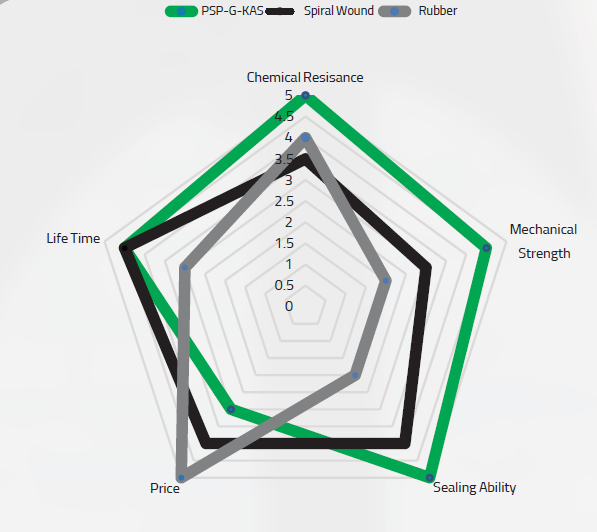
| row | Gasket size (inches) | product | Send | Quantity in each package |
|---|---|---|---|---|
| 1 | from 3/4 to 10 | plastic package | Cartoon pack | 4 |
| 2 | 12 to 30 | Plastic tape around the gaskets | wooden box | 4 |
| 3 | 32 and up | Plastic tape around the gaskets | wooden box | 2 |

Padideh Sadrab Paya Company is the first knowledge-based company in the field of implementing composite pipelines, anti-corrosion coatings, strength of concrete and metal structures, tanks and live line leakage. The engineering and industrial network of the country and focusing on the development of knowledge-based business with the support of more than 12 years of capable personnel experience, operates in the fields of water, oil and gas, petrochemical industries, refineries, heavy metal and mining industries.
Welcome to WordPress. This is your first post. Edit or delete
Welcome to WordPress. This is your first post. Edit or delete